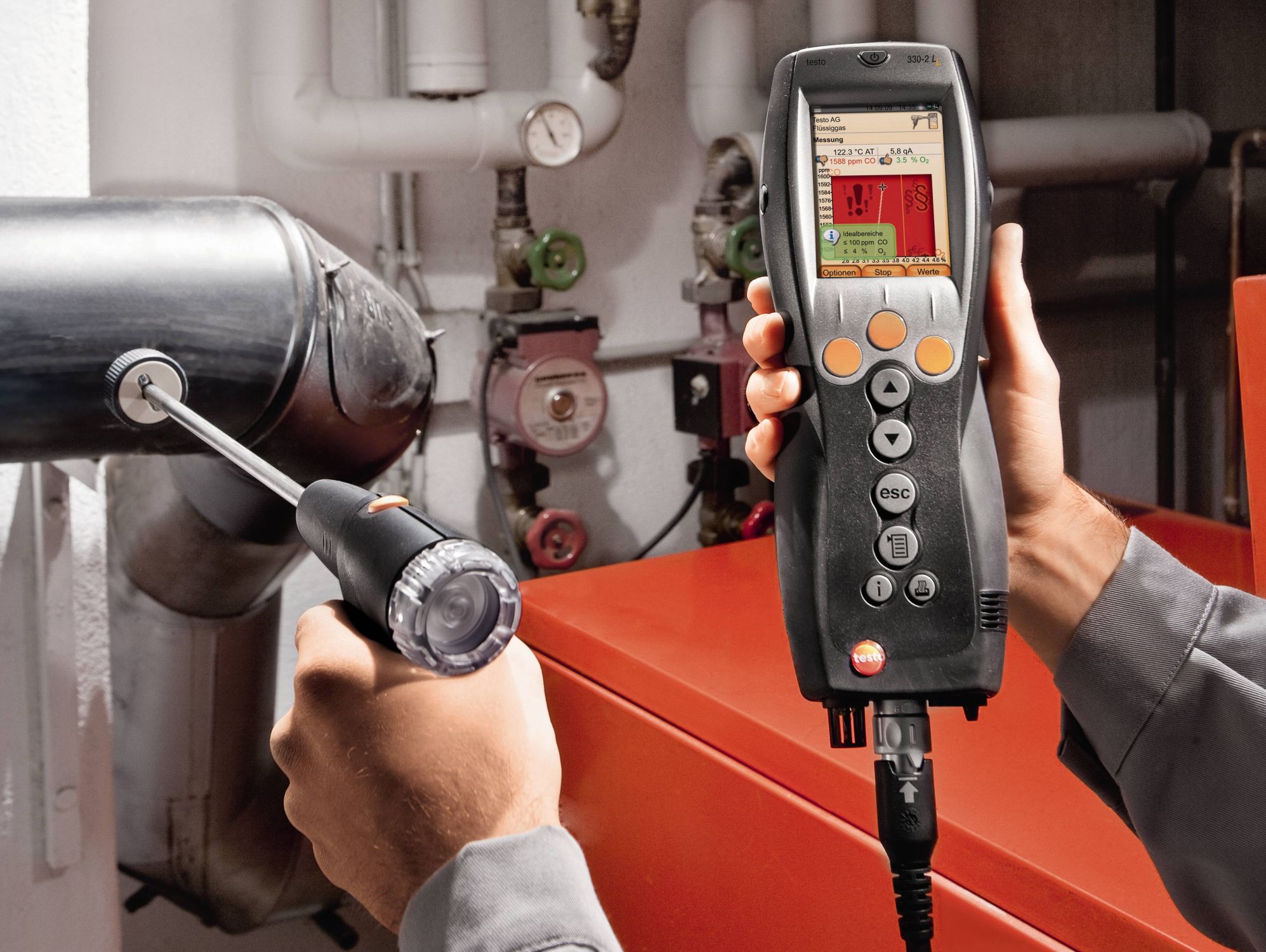- Home
- testo 330-1 LL v2010
testo 330-1 LL v2010 - Gran profesionalidad y sensores de larga duración
0563 3371testo 330-1 LL v2010 - Gran profesionalidad y sensores de larga duración
0563 3371• Pantalla en color de alta resolución para visualizar gráficamente los datos de medición
• Menús de medición avanzados – como la verificación de tuberías – para un análisis en profundidad de la instalación de calefacción
• Función logger para registrar la evolución de la medición
Sondas

0600 3692

0600 9760

0600 9787

0600 9797

0638 0330
Accesorios

0554 1213
Accesorios para sondas

0554 1202

0554 3329

0554 3330

0554 5762

0554 8764

0554 8765

0554 9760

0554 9761
Maletas

0516 3300
Ambient CO measurement in the heated environment
Carbon monoxide (CO) is a colourless, odourless and taste-free gas, but also poisonous. It is produced during the incomplete combustion of substances containing carbon (oil, gas, and solid fuels, etc.). If CO manages to get into the bloodstream through the lungs, it combines with haemoglobin thus preventing oxygen from being transported in the blood; this in turn will result in death through suffocation. This is why it is necessary to regularly check CO emissions at the combustion points of heating systems and the surroundings.

Measuring pressure on burners (nozzle pressure, gas flow pressure, etc.)
Standard readings taken during services of domestic heating systems include checking the gas pressure on the burners. This involves measuring the gas flow pressure and gas resting pressure. The flow pressure, also called supplied pressure, refers to the gas pressure of the flowing gas and resting pressure of the static gas. If the flow pressure for gas boilers is slightly outside the 18 to 25 mbar range, adjustments must not be made and the boiler must not be put into operation. If put into operation nonetheless, the burner will not be able to function properly, and explosions will occur when setting the flame and ultimately malfunctions; the burner will therefore fail and the heating system will shut down.
Measuring the flue gas parameters of the burner (CO, O2, and temperature, etc.)
The flue gas measurement for a heating system helps to establish the pollutants released with the flue gas (e.g. carbon monoxide CO or carbon dioxide CO2) and the heating energy lost with the warm flue gas. In some countries, flue gas measurement is a legal requirement. It primarily has two objectives:
- Ensuring the atmosphere is contaminated as little as possible by pollutants; and
- energy is used as efficiently as possible.
Stipulated pollutant quantities per flue gas volume and energy losses must never be exceeded.
Measurement in terms of results required by law takes place during standard operation (every performance primarily using the appliance). Using a Lambda probe (single hole or multi-hole probe), the measurement is taken at the centre of flow in the connecting pipe (in the centre of the pipe cross-section, not at the edge) between the boiler and chimney/flue. The measured values are recorded by the flue gas analyzer and can be logged either for print out or transfer to a PC at a later stage.
Measurement is taken by the installer at commissioning, and if necessary four weeks later by the flue gas inspector/chimney sweep, and then at regular intervals by the authorised service engineer.

Measuring temperatures on radiators
When measuring temperatures on radiators, the flow and return temperature are recorded in particular and assessed by the tradesman. The flow temperature is defined as the temperature of the thermal transfer medium (e.g. water) that the system is supplied with. The temperature of the medium flowing out of the system is accordingly called the return temperature. To prevent losses within the heat distribution system and achieve a better level of efficiency spot recording of flow and return temperatures are necessary. Implementation of relevant measures ultimately leads to hydraulic adjustment on the basis of knowledge about the flow and return temperatures. This defines a procedure with which every radiator or heating circuit of a flat radiator within a heating system is supplied at a set flow temperature with the precise amount of heat needed to achieve the ambient temperature required for the individual rooms. Flawed operating conditions will result in considerable excess consumption of electricity and heating energy. The German Energy Saving Regulation (EnEV) therefore requires hydraulic adjustment for systems being set up or overhauled for this very reason.
- Controlador Testo ZIV en su versión de 2000. El controlador Testo ZIV se utiliza para conectar los instrumentos de medición testo 320 y testo 330 con un programa de aplicación (sistema de gestión de distritos de barrido) de acuerdo con la interfaz versión 2.0 definida por la Asociación Central de Deshollinadores (ZIV, por su siglas en alemán). Por favor, consulte al fabricante de su programa de aplicación la compatibilidad con esta interfaz. Si Microsoft .NET Framework 4.0 no se ha instalado todavía en el ordenador, este debe descargarse del sitio web de Microsoft e instalarse en el sistema.
- Controlador de testo ZIV para testo 300, testo 320 y testo 330(v2.3, 64.11 MB)El controlador Testo ZIV se utiliza para conectar los instrumentos de medición testo 300, testo 320 y testo 330 con un programa de aplicación (sistema de gestión de distritos de barrido) de acuerdo con la interfaz definida por la Asociación Central de Deshollinadores (ZIV, por su siglas en alemán) en la versión 1.0 de 01. Agosto de 2012, versión 2.0 de 13. Febrero de 2017 así como la versión 3.0 de 02. Julio de 2021. Por favor, consulte al fabricante de su programa de aplicación la compatibilidad con esta interfaz.
- Update-Kit / Bootloader(V1.22, 1.24 MB)(testo 330 LL | testo 330i | testo 350 Unidad de Control + Caja analizadora | testo 320)
Si la actualización del firmware no se inicia en Windows 8.1 o Windows 10, se debe instalar un nuevo cargador de arranque en el dispositivo de medición una vez.
